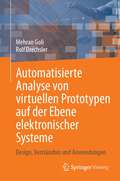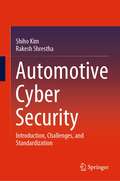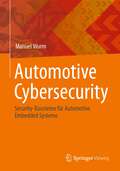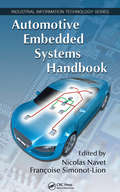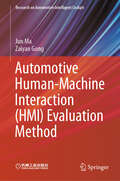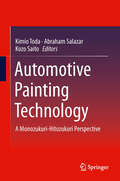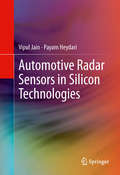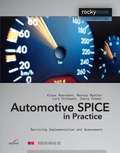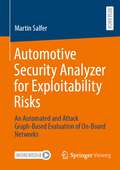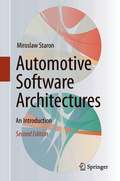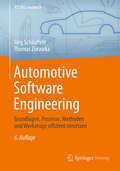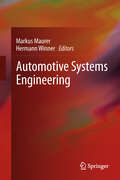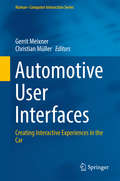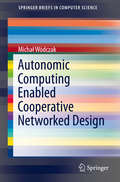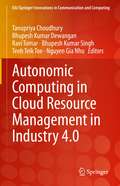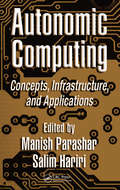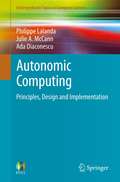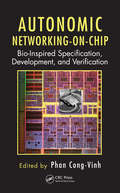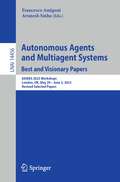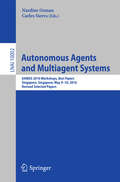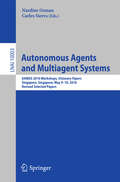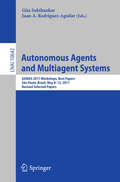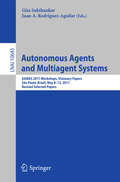- Table View
- List View
Automatisierte Analyse von virtuellen Prototypen auf der Ebene elektronischer Systeme: Design, Verständnis und Anwendungen
by Rolf Drechsler Mehran GoliDieses Buch beschreibt eine Reihe von SystemC-basierten Analysemethoden für virtuelle Prototypen, einschließlich Entwurfsverständnis, Verifikation, Sicherheitsvalidierung und Entwurfsraumuntersuchung. Der Leser erhält einen Überblick über die neuesten Forschungsergebnisse auf dem Gebiet der Electronic Design Automation (EDA) auf der elektronischen Systemebene (ESL). Die besprochenen Methoden ermöglichen es den Lesern, wichtige Aufgaben und Anwendungen im Entwurfsprozess leicht zu bewältigen.Übersetzt mit www.DeepL.com/Translator (kostenlose Version)
Automobile Automation: Distributed Cognition on the Road (Transportation Human Factors)
by Neville A. Stanton Victoria A. BanksIncreasing levels of driving automation has changed the role of the driver from active operator to passive monitor. However, Systems Design has been plagued by criticism for failing to acknowledge the new role of the driver within the system network. To understand the driver's new role within an automated driving system, the theory of Distributed Cognition is adopted. This approach provides a useful framework for the investigation of allocation of function between multiple agents in the driving system. A Systems Design Framework has been developed that outlines how the Distributed Cognition paradigm can be applied to driving using both qualitative and quantitative research methodologies.
Automotive Cyber Security: Introduction, Challenges, and Standardization
by Shiho Kim Rakesh ShresthaThis book outlines the development of safety and cybersecurity, threats and activities in automotive vehicles. This book discusses the automotive vehicle applications and technological aspects considering its cybersecurity issues. Each chapter offers a suitable context for understanding the complexities of the connectivity and cybersecurity of intelligent and autonomous vehicles. A top-down strategy was adopted to introduce the vehicles’ intelligent features and functionality. The area of vehicle-to-everything (V2X) communications aims to exploit the power of ubiquitous connectivity for the traffic safety and transport efficiency. The chapters discuss in detail about the different levels of autonomous vehicles, different types of cybersecurity issues, future trends and challenges in autonomous vehicles. Security must be thought as an important aspect during designing and implementation of the autonomous vehicles to prevent from numerous security threats and attacks. The book thus provides important information on the cybersecurity challenges faced by the autonomous vehicles and it seeks to address the mobility requirements of users, comfort, safety and security. This book aims to provide an outline of most aspects of cybersecurity in intelligent and autonomous vehicles. It is very helpful for automotive engineers, graduate students and technological administrators who want to know more about security technology as well as to readers with a security background and experience who want to know more about cybersecurity concerns in modern and future automotive applications and cybersecurity. In particular, this book helps people who need to make better decisions about automotive security and safety approaches. Moreover, it is beneficial to people who are involved in research and development in this exciting area. As seen from the table of contents, automotive security covers a wide variety of topics. In addition to being distributed through various technological fields, automotive cybersecurity is a recent and rapidly moving field, such that the selection of topics in this book is regarded as tentative solutions rather than a final word on what exactly constitutes automotive security. All of the authors have worked for many years in the area of embedded security and for a few years in the field of different aspects of automotive safety and security, both from a research and industry point of view.
Automotive Cybersecurity: Security-Bausteine für Automotive Embedded Systeme
by Manuel WurmDie aktuellen technologischen Veränderungen, allen voran die Digitalisierung, die Vernetzung von Verkehrssystemen und das Autonome Fahren, schaffen einerseits neue Mobilitätslösungen, andererseits rücken dadurch Fahrzeuge und die Automotive Infrastruktur als zunehmend attraktive Angriffsziele in den Fokus von Hackern und Cyberkriminellen. Die höhere Komplexität elektronischer Systeme hat eine größere Angriffsoberfläche zur Folge. Ein strukturierter und ganzheitlicher Ansatz macht diese Herausforderung beherrschbar. Dieses Buch verschafft dem Leser einen Überblick über die für ein umfassendes Securitykonzept erforderlichen Security-Bausteine. Die detaillierte Darstellung verschiedener Security-Mechanismen beschreibt einerseits wie Fahrzeugsysteme vor bestimmten Angriffen geschützt werden und macht andererseits deutlich, welche Herausforderungen und Abhängigkeiten deren Implementierung in ein Automotive Deeply-Embedded System mit sich bringt.
Automotive Embedded Systems Handbook (Industrial Information Technology)
by Navet Nicolas Simonot-Lion FrançoiseA Clear Outline of Current Methods for Designing and Implementing Automotive Systems Highlighting requirements, technologies, and business models, the Automotive Embedded Systems Handbook provides a comprehensive overview of existing and future automotive electronic systems. It presents state-of-the-art methodological and technical solutions in the areas of in-vehicle architectures, multipartner development processes, software engineering methods, embedded communications, and safety and dependability assessment. Divided into four parts, the book begins with an introduction to the design constraints of automotive-embedded systems. It also examines AUTOSAR as the emerging de facto standard and looks at how key technologies, such as sensors and wireless networks, will facilitate the conception of partially and fully autonomous vehicles. The next section focuses on networks and protocols, including CAN, LIN, FlexRay, and TTCAN. The third part explores the design processes of electronic embedded systems, along with new design methodologies, such as the virtual platform. The final section presents validation and verification techniques relating to safety issues. Providing domain-specific solutions to various technical challenges, this handbook serves as a reliable, complete, and well-documented source of information on automotive embedded systems.
Automotive Human-Machine Interaction (Research on Automotive Intelligent Cockpit)
by Jun Ma Zaiyan GongThis book focuses on the evaluation methodology for automotive human-machine interaction (HMI), which aim to reduce driving distractions, lower operational loads, optimize user experience design, and enhance user value.The book is divided into three parts. The first part, consisting of Chapters 1–3, introduces the evolution of automotive HMI and proposes a three-dimensional orthogonal evaluation system for automotive HMI that is comprehensive, systematic, and quantifiable. This evaluation system incorporates all evaluation items into a spatial matrix consisting of three dimensions: interaction tasks, interaction modalities, and evaluation indexes. The second part provides a comprehensive presentation and in-depth discussion of the evaluation indexes. The three rational evaluation indexes are utility, safety, and efficiency, which can be tested by the real-car driving simulator. The four emotional evaluation indexes are cognition, intelligence, value, and aesthetics. In orderto standardize the latter two subjective indexes, this book summarizes common differences in value between Chinese and European users and organizes typical aesthetic orientations in automotive UI based on art history research. The third part introduces the application of this HMI evaluation system in the automotive R&D process, including how to integrate the evaluation into a real product development process to achieve efficient product iteration.This book is suitable for intelligent cockpit and HMI designers, engineers, and researchers. It is also used as a reference for product managers and students in the field of intelligent connected vehicles.
Automotive Painting Technology: A Monozukuri-Hitozukuri Perspective
by Kozo Saito Abraham Salazar Kimio TodaThis book offers unique and valuable contributions to the field. It offers breadth and inclusiveness. Most existing works on automotive painting cover only a single aspect of this complex topic, such as the chemistry of paint or paint booth technology. Monozukuri and Hitozukuri are Japanese terms that can be translated as "making things" and "developing people" but their implications in Japanese are richer and more complex than this minimal translation would indicate. The Monozukuri-Hitozukuri perspective is drawn from essential principles on which the Toyota approach to problem-solving and continuous improvement is based. From this perspective, neither painting technology R&D nor painting technology use in manufacturing can be done successfully without integrating technological and human concerns involved with making and learning in the broadest sense, as the hyphen is meant to indicate. The editors provide case studies and examples -- drawn from Mr. Toda's 33 years of experience with automotive painting at Toyota and from Dr. Saito's 18 years experience with IR4TD, the research-for-development group he leads at the University of Kentucky -- that give details on how these two principles can be integrated for successful problem-solving and innovation in industry, in university R&D, and in the collaboration between the two. The book will bring readers up to date on progress in the field over the last decade to provide a basis for and to indicate fruitful directions in future R&D and technology innovation for automotive painting.
Automotive Radar Sensors in Silicon Technologies: Circuits And Systems
by Payam Heydari Vipul JainOne of the leading causes of automobile accidents is the slow reaction of the driver while responding to a hazardous situation. State-of-the-art wireless electronics can automate several driving functions, leading to significant reduction in human error and improvement in vehicle safety. With continuous transistor scaling, silicon fabrication technology now has the potential to substantially reduce the cost of automotive radar sensors. This book bridges an existing gap between information available on dependable system/architecture design and circuit design. It provides the background of the field and detailed description of recent research and development of silicon-based radar sensors. System-level requirements and circuit topologies for radar transceivers are described in detail. Holistic approaches towards designing radar sensors are validated with several examples of highly-integrated radar ICs in silicon technologies. Circuit techniques to design millimeter-wave circuits in silicon technologies are discussed in depth.
Automotive SPICE in Practice
by Klaus Hoermann Markus Mueller Lars Dittmann Joerg ZimmerAutomotive SPICE is a framework for designing and assessing software development processes. If implemented effectively, it leads to better processes and better product quality. It also helps to improve the cooperation among complex supply chains and between globally distributed development and engineering centers. Automotive SPICE has been derived from the ISO/IEC 15504 standard, also known as SPICE. It has been developed under the Automotive SPICE initiative by the consensus of several major car manufacturers such as Audi, BMW, Ford, Fiat, Daimler, Porsche, Volkswagen, and Volvo. Today, Automotive SPICE has become a standard in the international automotive industry. This book is written as a guide to help the reader understand and interpret the requirements of this standard and to implement Automotive SPICE in a real world application environment. It is written for engineers, practitioners, managers, and project managers who need practical guidance in applying or implementing the Automotive SPICE framework in his/her company. Important topics, such as traceability, functional safety (IEC 61508), and the relationship between Automotive SPICE and CMMI are given particular attention. This book is a definite must for practitioners involved in implementing Automotive SPICE in process improvement programs; a welcome aid for any assessor looking for clear, consistent, and constructive rating guidelines; and an invaluable resource for anyone concerned with engineering development processes in the automotive industry.
Automotive Security Analyzer for Exploitability Risks: An Automated and Attack Graph-Based Evaluation of On-Board Networks
by Martin SalferOur lives depend on automotive cybersecurity, protecting us inside and near vehicles. If vehicles go rogue, they can operate against the driver’s will and potentially drive off a cliff or into a crowd. The “Automotive Security Analyzer for Exploitability Risks” (AutoSAlfER) evaluates the exploitability risks of automotive on-board networks by attack graphs. AutoSAlfER’s Multi-Path Attack Graph algorithm is 40 to 200 times smaller in RAM and 200 to 5 000 times faster than a comparable implementation using Bayesian networks, and the Single-Path Attack Graph algorithm constructs the most reasonable attack path per asset with a computational, asymptotic complexity of only O(n * log(n)), instead of O(n²). AutoSAlfER runs on a self-written graph database, heuristics, pruning, and homogenized Gaussian distributions and boosts people’s productivity for a more sustainable and secure automotive on-board network. Ultimately, we enjoy more safety and security in and around autonomous, connected, electrified, and shared vehicles.
Automotive Software Architectures: An Introduction
by Miroslaw StaronThis book introduces the concept of software architecture as one of the cornerstones of software in modern cars. Following a historical overview of the evolution of software in modern cars and a discussion of the main challenges driving that evolution, Chapter 2 describes the main architectural styles of automotive software and their use in cars’ software. Chapter 3 details this further by presenting two modern architectural styles, i.e. centralized and federated software architectures. In Chapter 4, readers will find a description of the software development processes used to develop software on the car manufacturers’ side. Chapter 5 then introduces AUTOSAR – an important standard in automotive software. Chapter 6 goes beyond simple architecture and describes the detailed design process for automotive software using Simulink, helping readers to understand how detailed design links to high-level design. The new chapter 7 reports on how machine learning is exploited in automotive software e.g. for image recognition and how both on-board and off-board learning are applied. Next, Chapter 8 presents a method for assessing the quality of the architecture – ATAM (Architecture Trade-off Analysis Method) – and provides a sample assessment, while Chapter 9 presents an alternative way of assessing the architecture, namely by using quantitative measures and indicators. Subsequently Chapter 10 dives deeper into one of the specific properties discussed in Chapter 8 – safety – and details an important standard in that area, the ISO/IEC 26262 norm. Lastly, Chapter 11 presents a set of future trends that are currently emerging and have the potential to shape automotive software engineering in the coming years. This book explores the concept of software architecture for modern cars and is intended for both beginning and advanced software designers. It mainly aims at two different groups of audience – professionals working with automotive software who need to understand concepts related to automotive architectures, and students of software engineering or related fields who need to understand the specifics of automotive software to be able to construct cars or their components. Accordingly, the book also contains a wealth of real-world examples illustrating the concepts discussed and requires no prior background in the automotive domain. Compared to the first edition, besides the two new chapters 3 and 7 there are considerable updates in chapters 5 and 8 especially.
Automotive Software Engineering: Grundlagen, Prozesse, Methoden und Werkzeuge effizient einsetzen (ATZ/MTZ-Fachbuch)
by Jörg Schäuffele Thomas ZurawkaDieses Fachbuch enth#65533;lt die Grundlagen sowie zahlreiche Anregungen und praktische Beispiele zu Prozessen, Methoden und Werkzeugen, die zur sicheren Beherrschbarkeit von elektronischen Systemen und Software im Fahrzeug beitragen. Dabei werden der AUTOSAR-Standard und die Norm ISO 26 262 durchgehend behandelt. Die aktuelle Auflage ber#65533;cksichtigt Elektro- und Hybridantriebskonzepte sowie Fahrerassistenzsysteme und enth#65533;lt die Grundlagen zu Produktlinien- und Variantenmanagement. Seit Anfang der 1970er Jahre ist die Entwicklung von Kraftfahrzeugen gepr#65533;gt von einem rasanten Anstieg des Einsatzes von Elektronik und Software. Dieser Trend h#65533;lt bis heute an und wird getrieben von steigenden Kunden- und Umweltanforderungen. Nahezu alle Funktionen des Fahrzeugs werden inzwischen elektronisch gesteuert, geregelt oder #65533;berwacht. Die Realisierung von Funktionen durch Software bietet einzigartige Freiheitsgrade beim Entwurf. In der Fahrzeugentwicklung m#65533;ssen jedoch Randbedingungen wie hohe Zuverl#65533;ssigkeits- und Sicherheitsanforderungen, lange Produktlebenszyklen, begrenzte Kostenrahmen, kurze Entwicklungszeit und zunehmende Variantenvielfalt ber#65533;cksichtigt werden. In diesem Spannungsfeld steht Automotive Software Engineering.
Automotive Systems Engineering
by Hermann Winner Markus MaurerThis book reflects the shift in design paradigm in automobile industry. It presents future innovations, often referred as "automotive systems engineering". These cause fundamental innovations in the field of driver assistance systems and electro-mobility as well as fundamental changes in the architecture of the vehicles. New driving functionalities can only be realized if the software programs of multiple electronic control units work together correctly. This volume presents the new and innovative methods which are mandatory to master the complexity of the vehicle of the future.
Automotive User Interfaces: Creating Interactive Experiences in the Car (Human–Computer Interaction Series)
by Christian Müller Gerrit MeixnerThis book focuses on automotive user interfaces for in-vehicle usage, looking at car electronics and its software of hidden technologies (e. g. , ASP, ESP), comfort functions (e. g. , navigation, communication, entertainment) and driver assistance (e. g. , distance checking). The increased complexity of automotive user interfaces, driven by the need for using consumer electronic devices in cars as well as autonomous driving, has sparked a plethora of new research within this field of study. Covering a broad spectrum of detailed topics, the authors of this edited volume offers an outstanding overview of the current state of the art; providing deep insights into usability and user experience, interaction techniques and technologies as well as methods, tools and its applications; exploring the increasing importance of Human-Computer-Interaction (HCI) within the automotive industry. Automotive User Interfaces is intended as an authoritative and valuable resource for professional practitioners and researchers alike, as well as computer science and engineering students who are interested in automotive interfaces.
Autonomic Computing Enabled Cooperative Networked Design (SpringerBriefs in Computer Science)
by Michał WódczakThis book introduces the concept of autonomic computing driven cooperative networked system design from an architectural perspective. As such it leverages and capitalises on the relevant advancements in both the realms of autonomic computing and networking by welding them closely together. In particular, a multi-faceted Autonomic Cooperative System Architectural Model is defined which incorporates the notion of Autonomic Cooperative Behaviour being orchestrated by the Autonomic Cooperative Networking Protocol of a cross-layer nature. The overall proposed solution not only advocates for the inclusion of certain Decision Making Entities, but it also provides all the necessary implementation guidelines along with the pertinent standardisation orientated insight.
Autonomic Computing in Cloud Resource Management in Industry 4.0 (EAI/Springer Innovations in Communication and Computing)
by Nguyen Gia Nhu Tanupriya Choudhury Ravi Tomar Teoh Teik Toe Bhupesh Kumar Dewangan Bhupesh Kumar SinghThis book describes the next generation of industry—Industry 4.0—and how it holds the promise of increased flexibility in manufacturing, along with automation, better quality, and improved productivity. The authors discuss how it thus enables companies to cope with the challenges of producing increasingly individualized products with a short lead-time to market and higher quality. The authors posit that intelligent cloud services and resource sharing play an important role in Industry 4.0 anticipated Fourth Industrial Revolution. This book serves the different issues and challenges in cloud resource management CRM techniques with proper propped solution for IT organizations. The book features chapters based on the characteristics of autonomic computing with its applicability in CRM. Each chapter features the techniques and analysis of each mechanism to make better resource management in cloud.
Autonomic Computing: Concepts, Infrastructure, and Applications
by Manish Parashar Salim HaririThe complexity of modern computer networks and systems, combined with the extremely dynamic environments in which they operate, is beginning to outpace our ability to manage them. Taking yet another page from the biomimetics playbook, the autonomic computing paradigm mimics the human autonomic nervous system to free system developers and administrators from performing and overseeing low-level tasks. Surveying the current path toward this paradigm, Autonomic Computing: Concepts, Infrastructure, and Applications offers a comprehensive overview of state-of-the-art research and implementations in this emerging area.This book begins by introducing the concepts and requirements of autonomic computing and exploring the architectures required to implement such a system. The focus then shifts to the approaches and infrastructures, including control-based and recipe-based concepts, followed by enabling systems, technologies, and services proposed for achieving a set of "self-*" properties, including self-configuration, self-healing, self-optimization, and self-protection. In the final section, examples of real-world implementations reflect the potential of emerging autonomic systems, such as dynamic server allocation and runtime reconfiguration and repair.Collecting cutting-edge work and perspectives from leading experts, Autonomic Computing: Concepts, Infrastructure, and Applications reveals the progress made and outlines the future challenges still facing this exciting and dynamic field.
Autonomic Computing: Principles, Design and Implementation (Undergraduate Topics in Computer Science)
by Julie A. Mccann Ada Diaconescu Philippe LalandaThis textbook provides a practical perspective on autonomic computing. Through the combined use of examples and hands-on projects, the book enables the reader to rapidly gain an understanding of the theories, models, design principles and challenges of this subject while building upon their current knowledge. Features: provides a structured and comprehensive introduction to autonomic computing with a software engineering perspective; supported by a downloadable learning environment and source code that allows students to develop, execute, and test autonomic applications at an associated website; presents the latest information on techniques implementing self-monitoring, self-knowledge, decision-making and self-adaptation; discusses the challenges to evaluating an autonomic system, aiding the reader in designing tests and metrics that can be used to compare systems; reviews the most relevant sources of inspiration for autonomic computing, with pointers towards more extensive specialty literature.
Autonomic Networking-on-Chip: Bio-Inspired Specification, Development, and Verification (Embedded Multi-Core Systems)
by Phan Cong-VinhDespite the growing mainstream importance and unique advantages of autonomic networking-on-chip (ANoC) technology, Autonomic Networking-On-Chip: Bio-Inspired Specification, Development, and Verification is among the first books to evaluate research results on formalizing this emerging NoC paradigm, which was inspired by the human nervous system. The FIRST Book to Assess Research Results, Opportunities, & Trends in "BioChipNets" The third book in the Embedded Multi-Core Systems series from CRC Press, this is an advanced technical guide and reference composed of contributions from prominent researchers in industry and academia around the world. A response to the critical need for a global information exchange and dialogue, it is written for engineers, scientists, practitioners, and other researchers who have a basic understanding of NoC and are now ready to learn how to specify, develop, and verify ANoC using rigorous approaches. Offers Expert Insights Into Technical Topics Including: Bio-inspired NoC How to map applications onto ANoC ANoC for FPGAs and structured ASICs Methods to apply formal methods in ANoC development Ways to formalize languages that enable ANoC Methods to validate and verify techniques for ANoC Use of "self-" processes in ANoC (self-organization, configuration, healing, optimization, protection, etc.) Use of calculi for reasoning about context awareness and programming models in ANoC With illustrative figures to simplify contents and enhance understanding, this resource contains original, peer-reviewed chapters reporting on new developments and opportunities, emerging trends, and open research problems of interest to both the autonomic computing and network-on-chip communities. Coverage includes state-of-the-art ANoC architectures, protocols, technologies, and applications. This volume thoroughly explores the theory behind ANoC to illustrate strategies that enable readers to use formal ANoC methods yet still make sound judgments and allow for reasonable justifications in practice.
Autonomous Agents and Multiagent Systems. Best and Visionary Papers: AAMAS 2022 Workshops, Virtual Event, May 9–13, 2022, Revised Selected Papers (Lecture Notes in Computer Science #13441)
by Fei Fang Francisco S. MeloThis book constitutes thoroughly refereed and revised selected best and visionary papers from the Workshops held at the International Conference on Autonomous Agents and Multiagent Systems AAMAS 2022, which took place online, during May 9–13, 2022.The 5 best papers and 4 visionary papers included in this book stem from the following workshops: - 13th Workshop on Optimization and Learning in Multi-agent Systems (OptLearnMAS);- 23rd Workshop on Multi-Agent Based Simulation (MABS);- 6th Workshop on Agent-Based Modelling of Urban Systems (ABMUS);- 10th Workshop on Engineering Multi-Agent Systems (EMAS);- 1st Workshop on Rebellion and Disobedience in AI (RaD-AI).There was a total of 59 submissions to these workshops.
Autonomous Agents and Multiagent Systems. Best and Visionary Papers: AAMAS 2023 Workshops, London, UK, May 29 –June 2, 2023, Revised Selected Papers (Lecture Notes in Computer Science #14456)
by Francesco Amigoni Arunesh SinhaThis book contains visionary and best papers from the workshops held at the International Conference on Autonomous Agents and Multiagent Systems, AAMAS 2023, held in London, UK, during May 29–June 2, 2023.The 12 regular papers, 5 best papers and 7 visionary papers, presented were carefully reviewed and selected from a total of more than 110 contributions to the workshops. They focus on emerging topics and new trends in the area of autonomous agents and multiagent systems and stem from the following workshops:- Workshop on Autonomous Robots and Multirobot Systems (ARMS)- Workshop on Adaptive and Learning Agents (ALA)- Workshop on Interdisciplinary Design of Emotion Sensitive Agents (IDEA)- Workshop on Rebellion and Disobedience in Artificial Intelligence (RaD-AI)- Workshop on Neuro-symbolic AI for Agent and Multi-Agent Systems (NeSyMAS)- Workshop on Multiagent Sequential Decision Making under Uncertainty (MSDM)- Workshop on Citizen-Centric Multi-Agent Systems (C-MAS)
Autonomous Agents and Multiagent Systems: AAMAS 2016 Workshops, Best Papers, Singapore, Singapore, May 9-10, 2016, Revised Selected Papers (Lecture Notes in Computer Science #10002)
by Nardine Osman Carles SierraThis book features a selection of best papers from 11 workshops held at the International Conference on Autonomous Agents and Multiagent Systems, in Singapore in May 2016. The 11 full papers were carefully reviewed and selected for inclusion in this volume. They cover specific topics, both theoretical and applied, in the general area of autonomous agents and multiagent systems.
Autonomous Agents and Multiagent Systems: AAMAS 2016 Workshops, Visionary Papers, Singapore, Singapore, May 9-10, 2016, Revised Selected Papers (Lecture Notes in Computer Science #10003)
by Nardine Osman Carles SierraThis book features a selection of best papers from 11 workshops held at the International Conference on Autonomous Agents and Multiagent Systems, in Singapore in May 2016. The 11 full papers were carefully reviewed and selected for inclusion in this volume. They cover specific topics, both theoretical and applied, in the general area of autonomous agents and multiagent systems.
Autonomous Agents and Multiagent Systems: AAMAS 2017 Workshops, Best Papers, São Paulo, Brazil, May 8-12, 2017, Revised Selected Papers (Lecture Notes in Computer Science #10642)
by Gita Sukthankar Juan A. Rodriguez-AguilarThis book features a selection of best papers from 13 workshops held at the International Conference on Autonomous Agents and Multiagent Systems, AAMAS 2017, held in Sao Paulo, Brazil, in May 2017. The 17 full papers presented in this volume were carefully reviewed and selected for inclusion in this volume. They cover specific topics, both theoretical and applied, in the general area of autonomous agents and multiagent systems.
Autonomous Agents and Multiagent Systems: AAMAS 2017 Workshops, Visionary Papers, São Paulo, Brazil, May 8-12, 2017, Revised Selected Papers (Lecture Notes in Computer Science #10643)
by Gita Sukthankar Juan A. Rodriguez-AguilarThis book features a selection of best papers from 13 workshops held at the International Conference on Autonomous Agents and Multiagent Systems, AAMAS 2017, held in Sao Paulo, Brazil, in May 2017. The 17 full papers presented in this volume were carefully reviewed and selected for inclusion in this volume. They cover specific topics, both theoretical and applied, in the general area of autonomous agents and multiagent systems.
